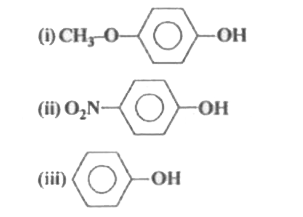निम्नलिखित को उनके अम्लीय सामर्थ्य के बढ़ते क्रम में लिखिए-C6H5OH,m−ClC6H4OH,p−ClC6H4OH
(i)C6H5OH<p−ClC6H4OH<m−ClC6H4OH
Topper's Solved these Questions
- ऑक्ससीजन युक्त क्रियात्मक समूह वाले योगिक ( भाग -1 ) BOOK - MITTAL PUBLICATIONCHAPTER - ऑक्ससीजन युक्त क्रियात्मक समूह वाले योगिक ( भाग -1 ) EXERCISE - अन्य महत्वपूर्ण प्रश्नोत्तर (निबन्धात्मक प्रश्न)
6 Videos
- ऑक्ससीजन युक्त क्रियात्मक समूह वाले योगिक ( भाग -1 ) BOOK - MITTAL PUBLICATIONCHAPTER - ऑक्ससीजन युक्त क्रियात्मक समूह वाले योगिक ( भाग -1 ) EXERCISE - अन्य महत्वपूर्ण प्रश्नोत्तर (अति लघूत्तरात्मक प्रश्न )
19 Videos
- ऑक्ससीजन युक्त क्रियात्मक समूह वाले योगिक ( भाग -1 ) BOOK - MITTAL PUBLICATIONCHAPTER - ऑक्ससीजन युक्त क्रियात्मक समूह वाले योगिक ( भाग -1 ) EXERCISE - अन्य महत्वपूर्ण प्रश्नोत्तर (अतिलघूत्तरात्मक प्रश्न)
35 Videos
- उपसहसंयोजक योगिकBOOK - MITTAL PUBLICATIONCHAPTER - उपसहसंयोजक योगिकEXERCISE - TEST YOUR SKILLS
17 Videos
- ऑक्सीजन युक्त क्रियात्मक समूह वाले यौगिकBOOK - MITTAL PUBLICATIONCHAPTER - ऑक्सीजन युक्त क्रियात्मक समूह वाले यौगिकEXERCISE - विभिन्न प्रतियोगी परीक्षाओं में पूछे गए प्रश्न
52 Videos
Similar Questions
ऐल्कोहॉल क्या है? इन्हें किस प्रकार वर्गीकृत करते हैं?
View Solutionनिम्नलिखित को उनकी अम्लीयता के घटते क्रम में व्यवस्थित कीजिए-

View Solutionनिम्न ऐल्कोहॉल जल में विलेय होते हैं, उच्च ऐल्कोहॉल नहीं। क्यों ?
View Solutionनिम्न के पूर्ण नाम एवं संरचना लिखिए -
EDTA4−
View Solutionनिम्न में से कौन सा एक नाभिकस्नेही अभिक्रिया देगा
View SolutionArrange the following :
(a) C6H5OH,m−ClC6H4OH and p−ClC6H4OH in decreasing order of their acidity.
(b) m−NO2C6H4OH,C6H5OH and p−NO2C6H4OH in decreasing order of their acidity.
(c ) o−,m− and p− bromophenol in order of increasing basicity.
(d) o−,m− and p−nitrophenol in order of increasing basicity.
(e ) Carbonic acid , phenol , p-nitrophenol and benzoic acid in order of increasing acidity.
(f) m-Cresol,phenol,m-chlorophenol and m-nitrophenol in order of increasing acidity.
View SolutionC_(2)H_(5)OH and C_(6)H_(5)OH can be distinguished by
View SolutionC_(2)H_(5)OH and C_(6)H_(5)OH can be distinguished by
View SolutionArrange the following in decreasing order of their acidic character:
(i) p−CH3O−C6H4OH,
(ii) p−NO2−C6H4OH,
(iii) C6H5OH
View SolutionThe compound that reacts with NaOH . (A) CH_(3)OH (B) CH_(3)CH_(2)OH (C) C_(6)H_(5)OH (D) C_(6)H_(5)CH_(2)OH
View SolutionThe major products that are formed by heating C6H5−CH2−O−C6H5 with HI
(A) 2C6H5I
(B) C6H5CH2IandC6H5OH
(C) 2C6H5OH
(D) C6H5CH2OHandC6H5I
View Solutionनिम्नलिखित को उनके अम्लीय सामर्थ्य के बढ़ते क्रम में लिखिए-(ii)C6H5OH,m−NO2C6H4OH,p−CH3O−C6H4OH,O−NO2C6H4OH,p−NO2C6H4OH
View SolutionC_(6)H_(5)OH is weaker/stronger acid than C_(6)H_(11)OH .
View Solutionकौन - सा युग्म समावयवी है?
(i) C6H6 और C2H6
(ii) C4H5 और C4H10
(iii) C2H5OH और CH3OCH3
(iv) C5H5 और C6H12
View SolutionIdentify the electrophile and nucleophile in the following reactions :
(a) C6H5N2Cl+KI→C6H5I+KCL
(b) C6H5N2Cl+C6H5OH→C6H5N=N−C6H4OH
(c) C6H5N2Cl+CH3OH→C6H5OCH3
(d) C6H5N2Cl+H2O→C6H5OH
View Solution
